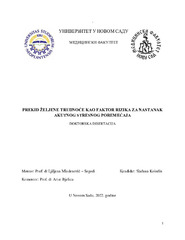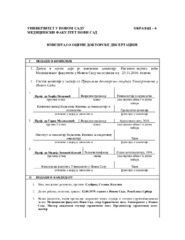Приказ основних података о дисертацији
Prekid željene trudnoće kao faktor rizika za nastanak akutnog stresnog poremećaja
Termination of desired pregnancy as a risk factor for the development of acute stress disorder
| dc.contributor.advisor | Mladenović-Segedi, Ljiljana | |
| dc.contributor.advisor | Bjelica, Artur | |
| dc.contributor.other | Petrović, Đorđe, S. | |
| dc.contributor.other | Malenković, Goran | |
| dc.contributor.other | Zotović Kostić, Marija | |
| dc.contributor.other | Milutinović, Dragana | |
| dc.contributor.other | Grujić, Zorica | |
| dc.creator | Коледин, Слађана | |
| dc.date.accessioned | 2022-10-14T11:55:46Z | |
| dc.date.available | 2022-10-14T11:55:46Z | |
| dc.date.issued | 2022-09-30 | |
| dc.identifier.uri | https://www.cris.uns.ac.rs/DownloadFileServlet/Disertacija165718614650624.pdf?controlNumber=(BISIS)120629&fileName=165718614650624.pdf&id=20073&source=NaRDuS&language=sr | sr |
| dc.identifier.uri | https://www.cris.uns.ac.rs/record.jsf?recordId=120629&source=NaRDuS&language=sr | sr |
| dc.identifier.uri | https://www.cris.uns.ac.rs/DownloadFileServlet/IzvestajKomisije165718615682242.pdf?controlNumber=(BISIS)120629&fileName=165718615682242.pdf&id=20074&source=NaRDuS&language=sr | sr |
| dc.identifier.uri | https://nardus.mpn.gov.rs/handle/123456789/20741 | |
| dc.description.abstract | Pobačaj željene trudnoće predstavlja za ženu iznenadno, negativno životno iskustvo, koje u manjoj ili većoj meri može negativno da utiče na fizičko i psihičko zdravlje žene čime predstavlja potencijalni stresogeni ili traumatski događaj. Prolazeći kroz ovaj stresni događaj, žena preživljava ne samo fizički nego i psihički bol. Stres predstavlja reakciju organizma, putem uključivanja adaptacionih sistema, na stresni faktor koji ima takav intenzitet delovanja da prevazilazi osnovni nivo funkcionisanja. Akutni stresni poremećaj (ASP) se razvija neposredno, odmah nakon traumatičnog događaja i traje od 3 dana do mesec dana, značajno remeti ili pogoršava dotadašnje funkcionisanje osobe. Ukoliko nastali simptomi traju i posle mesec dana od traumatičnog događaja može doći do razvoja posttraumatskog stresnog poremećaja (PTSP) koji predstavlja odloženu ili produženu reakciju na stresni događaj, Osnovni ciljevi ovog istraživanja bili su da se ispita pojava ASP I PTSP-a kod žena nakon pobačaja željene trudnoće. Istraživanje je sprovedeno u vidu prospektivne studije, tokom tri posete direktnim anonimnim anketiranjem pacijentkinja koje su došle na prekid trudnoće na Kliniku za ginekologiju i akušerstvo u Novom Sadu. Za ispitivanje su korišćena četiri posebno konstruisana upitnika. Ispitanice su bile podeljene u dve grupe, ispitivanu koja je obuhvatala 79 žena sa spontanim pobačajem željene trudnoće i namernim pobačajem željene trudnoće iz zdravstvenih indikacija i kontrolnu grupu sa 81. ispitanicom koje su se javile radi prekida neželjene trudnoće. U obe grupe prosečna starost iznosila je oko 31. godinu. Najveći broj ispitanica u obe ispitivane grupe ima srednju stručnu spremu, nisu u radnom odnosu, udate su, imaju jedno dete i do tada nisu imale prekid trudnoće. Korišćenjem skale trenutnog raspoloženja ispitanica, nakon 2 sata od pobačaja željene trudnoće utvrđeno je da su na prvoj kontroli kod pacijentkinja ispitivane grupe dominirala negativna osećanja, dok su kod pacijentkinja iz kontrolne grupe bila izraženija pozitivna osećanja. Na drugoj kontroli u obe grupe ispitanica dominiralo je pozitivno raspoloženje, ali je ono u kontrolnoj grupi, bilo statistički značajno više. Pirsonovim hi-kvadrat testom je dobijeno da postoje statistički značajne razlike između ispitivane i kontrolne grupe u učestanosti pojavljivanja ASP-a kako 2h tako i 14 dana nakon pobačaja trudnoće. Dobijeno je i da postoje statistički značajne razlike između navedenih grupa, u učestalosti pojavljivanja PTSP-a 2 sata nakon pobačaja, dok razlike nisu postojale nakon 14 dana. Kada je u pitanju pojava ASP-a u ispitivanoj grupi, dobili smo da je značajno statistički veći broj ispitanica ispoljio znake akutnog stresnog poremećaja 2 sata nakon pobačaja u odnosu na drugu kontrolu, što se podudara sa rezultatima dobijenim i u kontrolnoj grupi. Pomoću skale za procenu nivoa blagostanja u periodu tugovanja dobilli smo da postoji statistički značajna razlika između ispitivane i kontrolne grupe 2h, ali i nakon 14 dana nakon pobačaja. Istraživanjem smo utvrdili da kod velikog broja pacijentkinja koje su imale pobačaj željene trudnoće dominiraju negativna osećanja i 14 dana nakon pobačaja, dok je u istom period u svega 21,52% slučajeva došlo do pojave akutnog stresnog poremećaja. Kada je u pitanju posttraumatski stresni poremećaj, pojava ovog poremećaja je zanemarljiva obzirom da se PTSP javio u svega 2,53% slučajeva, 14 dana nakon pobačaja željene trudnoće. Od veoma velikog značaja je to da zdravstveni radnici koji su u kontaktu sa pacijentkinjama kod kojih se planira prekid željena trudnoće iz indikacija, već prilikom prve posete sprovedu procenu njenog psihičkog stanja, kako bi pravovremeno i na najbolji način bili podrška, kada je to od presudnog značaja za zaustavljanje daljeg razvoja stresnog poremećaja. | sr |
| dc.description.abstract | Termination of desired pregnancy represents an abrupt negative life experience, which can, to a greater or lesser extent negatively influence a woman’s physical and psychological health. All the previously mentioned presents a potential stressor or a traumatic event. Experiencing such a stressful event, a women is undergoing not only physical but psychological pain as well. Stress is the body’s response through adaptive system activation caused by a stressor which is of such reaction intensity that it exceeds the basic level of functioning. Acute stress disorder (ASD) develops straight after a traumatic event and lasts from 3 days to a month. Consequently, it significantly disrupts or worsens the normal functioning of a person. In case the symptoms persist even beyond a month after the traumatic event, these can lead to the development of posttraumatic stress disorder (PTSD) which can represent delayed or extended reaction to a stressor. The main objectives of this research have been to question the occurrence of ASD and PTSD in women after the termination of desired pregnancy. The research was conducted in the form of a prospective study during three visits by direct anonymous questionnaires of patients who have come to the Department of Obstetrics and Gynecology of the Clinical Center of Vojvodina in Novi Sad to terminate their pregnancy. Four specially designed questionnaires were used for this testing. Respondents were largely divided into two groups, study group comprising of 79 women who had spontaneous abortion of a wanted pregnancy and deliberate abortion of wanted pregnancies due to health indications as well as a control group which comprised of 81 respondent who have come for the abortion of unwanted pregnancy. Average age in both groups was around 31year old. Most of the respondents in both test groups were of secondary education, unemployed, married with one child and had not had a previous abortion. Using the current mood scale two hours after the termination of wanted pregnancies indicated that during the first doctor’s appointment patients experienced predominately negative feelings, whereas the patients from the other group more commonly expressed positive feelings. At the second doctor’s appointment, positive mood was dominant in both groups of respondents, but it was statistically speaking significantly higher in the control group. Pearson's chi-squared test showed that there are statistically significant differences between the study and the control group in the frequency of occurrence of ADS both 2 hours and 14 days after the pregnancy termination. What was shown is that there are statistically significant differences between the aforementioned groups when it came to the occurrence of PTST 2 hours after the abortion, whereas there were no differences after 14 days. When it comes to the occurrence of ADS within the study group, it was shown that there was a statistically higher number of respondents who showed acute stress symptoms 2 hours after the abortion when compared to the control group, which coincided with the results attained in the control group. With the help of the current mood scale in the grievance period it was proved that there was statistically significant difference between the study and the control group 2 hours after the termination but also after 14 days. The research has further confirmed that in large number of patients who had a termination of a wanted pregnancy negative feelings were prevalent even after 14 days after the termination whereas in the same time period in merely 21.52% of cases acute stress disorder occurred. When it comes to posttraumatic stress disorder, the occurrence of this disorder is negligible considering that the PTST appeared in only 2.53% of cases, 14 days after the termination of desired pregnancy. It is of great significance that health workers at the very first appointment, with patients who have a planned termination of desired pregnancy, conduct a mental state assessment so as to be able to provide appropriate support in the best and timely manner at the moment when it is of crucial importance for preventing the further development of the stress disorder development. | en |
| dc.language | sr (latin script) | |
| dc.publisher | Универзитет у Новом Саду, Медицински факултет | sr |
| dc.rights | openAccess | en |
| dc.rights.uri | https://creativecommons.org/licenses/by-nc-nd/4.0/ | |
| dc.source | Универзитет у Новом Саду | sr |
| dc.subject | spontani pobačaj | sr |
| dc.subject | Abortion, Spontaneous | en |
| dc.subject | namerni pobačaj | sr |
| dc.subject | psihološki stres | sr |
| dc.subject | tuga | sr |
| dc.subject | akutni stresni poremećaj | sr |
| dc.subject | posttraumatski stresni poremećaj | sr |
| dc.subject | ankete i upitnici | sr |
| dc.subject | Abortion, Induced | en |
| dc.subject | Stress, Psychological | en |
| dc.subject | Sadness | en |
| dc.subject | Stress Disorders, Traumatic, Acute | en |
| dc.subject | Stress Disorders, Post-Traumatic | en |
| dc.subject | Surveys and Questionnaires | en |
| dc.title | Prekid željene trudnoće kao faktor rizika za nastanak akutnog stresnog poremećaja | sr |
| dc.title.alternative | Termination of desired pregnancy as a risk factor for the development of acute stress disorder | en |
| dc.type | doctoralThesis | sr |
| dc.rights.license | BY-NC-ND | |
| dc.identifier.fulltext | http://nardus.mpn.gov.rs/bitstream/id/146362/Izvestaj_komisije_12654.pdf | |
| dc.identifier.fulltext | http://nardus.mpn.gov.rs/bitstream/id/146361/Disertacija_12654.pdf | |
| dc.identifier.rcub | https://hdl.handle.net/21.15107/rcub_nardus_20741 |



